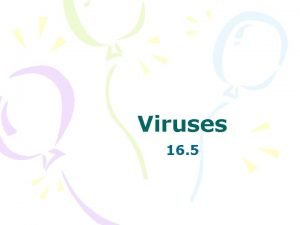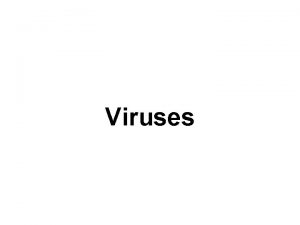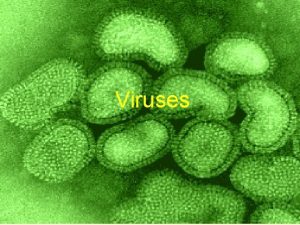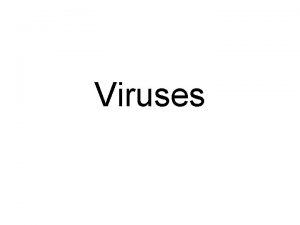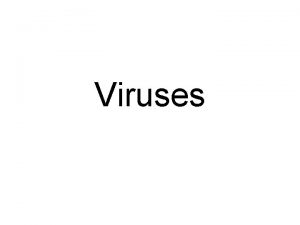Viruses EQ Are viruses considered living Why or











- Slides: 11

Viruses EQ: Are viruses considered living? Why or why not?

Virus Reproduction A virus is nonliving. Viruses can reproduce only by infecting living cells.

Virus Structure and Composition Viruses have a very simple construction. Capsid: protein coat surrounding a virus Surface proteins: help virus bind to the cell Genetic material: DNA or RNA Bacteriophage: virus that infects a bacterial cell

Viral Infections Viruses use their genetic information to reproduce inside living cells. Two types of infection Lytic – quick cell death Lysogenic – delayed cell death Lysogenic infection Lytic infection

Lytic Infections 1. The virus injects DNA into a bacterium. 2. Viral genes are transcribed by the host cell. 5. Viral enzymes lyse the bacterium’s cell wall. The new viruses escape. 4. The proteins and nucleic acids assemble into new viruses. 3. The bacterium makes new viral proteins and nucleic acid.

Lytic Infections Analogy A lytic virus is similar to the Wild West of the American frontier. The host cell’s DNA is chopped up. Virus uses host cell to make viral DNA and viral proteins. The host cell bursts, releasing hundreds of virus particles.

Lysogenic Infections The prophage may replicate with the bacterium for many generations. The viral DNA inserts itself into the bacterial chromosome. Prophage The virus injects DNA into the bacterium. The prophage can exit the bacterial chromosome and enter a lytic cycle.

An RNA Virus: The Common Cold Once the cold virus has penetrated the host’s cells, it uses the host’s cellular machinery to replicate itself. The virus makes many copies of its RNA. Cytoplasm The copies are translated by the host into new viral parts. The parts assemble into new viruses and burst from the host cell.

An RNA Virus: HIV makes a DNA copy of itself that inserts into the host’s DNA. There, it may remain inactive for many cell cycles. A DNA copy of the viral RNA is made. DNA The parts assemble into new viruses and burst from the host cell. The copy is inserted into the host’s genome. Cytoplasm It is later transcribed and translated into new viral parts.

Viruses and Cells

Summary of Viruses • Viruses reproduce by infecting living cells. • Some viruses replicate immediately; others initially persist in an inactive state within the host. Lysogenic infection Lytic infection
 Insidan region jh
Insidan region jh Why are viruses considered nonliving?
Why are viruses considered nonliving? Why are viruses considered nonliving
Why are viruses considered nonliving Unlike lytic viruses lysogenic viruses do not
Unlike lytic viruses lysogenic viruses do not Youtube
Youtube How do viruses differ from living things
How do viruses differ from living things Andreas carlsson bye bye bye
Andreas carlsson bye bye bye Venn diagram living and non living
Venn diagram living and non living Tomato living or nonliving
Tomato living or nonliving Living non living dead
Living non living dead This organelle often ships proteins to the golgi apparatus
This organelle often ships proteins to the golgi apparatus Why is fiber class evidence
Why is fiber class evidence


